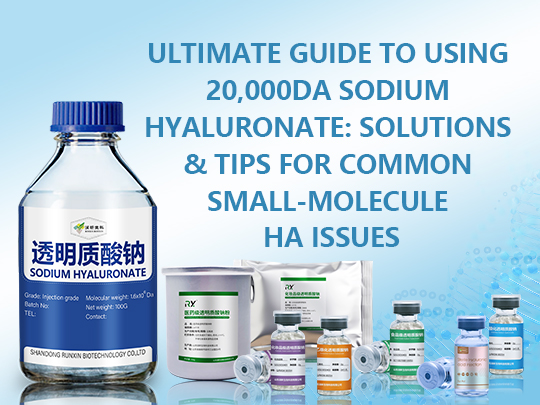Introduction
As a leading manufacturer of high-quality Sodium Hyaluronate and Chondroitin Sulfate with over 28 years of expertise, Shandong Runxin Bio-Tech understands the challenges our clients face when using low-molecular-weight Hyaluronic Acid (HA). In this article, we’ll dive deep into the applications, best practices, and troubleshooting tips for 20,000 Da Sodium Hyaluronate—helping you maximize performance while avoiding common pitfalls.
What Is 20,000 Da Sodium Hyaluronate?
20,000 Da Sodium Hyaluronate is a small-molecule HA known for its superior penetration and hydration capabilities. Unlike high-molecular-weight HA, which forms a surface barrier, this lightweight version absorbs quickly into the skin or targeted tissues, making it ideal for serums, injectables, functional foods, and advanced biomaterial applications.

Common Problems & Practical Solutions
Based on feedback from global customers, here are the most frequent issues and how to solve them:
1. Clumping or Poor Dissolution
- Problem: Low-MW HA powders tend to clump when mixed with water or solvents.
- Solution:
- Always sprinkle the powder slowly into the solvent while stirring at medium-high speed.
- Use deionized water at room temperature for even dispersion.
- Pre-hydrate for at least 60 minutes to ensure full dissolution.
2. Reduced Stability in Formulations
- Problem: Small-molecule HA is more sensitive to pH, temperature, and enzymatic degradation.
- Solution:
- Maintain pH between 6.0–7.5 for optimal stability.
- Avoid long-term exposure to high temperatures. Add antioxidants like vitamin E if necessary.
- Use airtight packaging to prevent moisture absorption and microbial growth.
3. Skin Irritation in Cosmetic Use
- Problem: Some end-users report slight irritation or redness.
- Solution:
- Combine with soothing agents (e.g., panthenol, aloe vera).
- Perform patch testing before full application.
- Ensure the HA concentration does not exceed 2% in leave-on products.
4. Viscosity Control Challenges
- Problem: Even low-MW HA can over-thicken if used incorrectly.
- Solution:
- Start with a low concentration (0.5%–1.5%) and adjust gradually.
- For lightweight textures, consider blending with other humectants like glycerin.

Recommended Applications
- Skincare: Deep-hydrating serums, masks, microneedling solutions.
- Nutraceuticals: Functional beverages, capsules, and gummies.
- Pharmaceuticals: Eye drops, joint health injections, wound healing gel.
- Biomedical Research: Cell culture, tissue engineering, drug delivery systems.
Why Choose Our 20,000 Da Sodium Hyaluronate?
- ✅ High Purity & Bioactivity: Produced under cGMP & ISO13485 certifications.
- ✅ Batch Consistency: Fully tested for molecular weight, purity, and heavy metals.
- ✅ Customization Support: Available upon request for specific solubility, particle size, or certification (HALAL, Kosher, etc.).
Pro Tips from Our Experts
- Always use stainless steel or plastic equipment when handling HA solutions to avoid contamination.
- For injectable or oral applications, ensure your HA supplier provides full traceability and compliance documentation (e.g., FDA, FSSC22000).
- Consider using our Acetylated or Nano Hyaluronate for enhanced stability and penetration in cosmetic formulations.
Conclusion
20,000 Da Sodium Hyaluronate offers incredible benefits but requires careful formulation and handling. With the right techniques—and a trusted supplier like Runxin Bio-Tech—you can avoid common issues and create high-performance products that stand out in the global market.
Explore our range of premium HA and chondroitin sulfate products—message us for free samples and technical documents!


